[English] 日本語
 Yorodumi
Yorodumi- PDB-6vzo: Crystal structure of human PPARgamma ligand binding domain (Prote... -
+ Open data
Open data
- Basic information
Basic information
| Entry | Database: PDB / ID: 6vzo | ||||||
|---|---|---|---|---|---|---|---|
| Title | Crystal structure of human PPARgamma ligand binding domain (Protein delipidated by denature and refold) | ||||||
 Components Components | Peroxisome proliferator-activated receptor gamma | ||||||
 Keywords Keywords | TRANSCRIPTION / Nuclear receptors / TZDs / Drug design / Therapeutic targets | ||||||
| Function / homology |  Function and homology information Function and homology informationprostaglandin receptor activity / : / negative regulation of receptor signaling pathway via STAT / MECP2 regulates transcription factors / negative regulation of vascular endothelial cell proliferation / negative regulation of extracellular matrix assembly / negative regulation of connective tissue replacement involved in inflammatory response wound healing / positive regulation of cholesterol transport / negative regulation of cellular response to transforming growth factor beta stimulus / arachidonate binding ...prostaglandin receptor activity / : / negative regulation of receptor signaling pathway via STAT / MECP2 regulates transcription factors / negative regulation of vascular endothelial cell proliferation / negative regulation of extracellular matrix assembly / negative regulation of connective tissue replacement involved in inflammatory response wound healing / positive regulation of cholesterol transport / negative regulation of cellular response to transforming growth factor beta stimulus / arachidonate binding / positive regulation of adiponectin secretion / negative regulation of cardiac muscle hypertrophy in response to stress / DNA binding domain binding / lipoprotein transport / positive regulation of vascular associated smooth muscle cell apoptotic process / WW domain binding / positive regulation of fatty acid metabolic process / STAT family protein binding / response to lipid / negative regulation of type II interferon-mediated signaling pathway / LBD domain binding / negative regulation of cholesterol storage / negative regulation of SMAD protein signal transduction / E-box binding / lipid homeostasis / alpha-actinin binding / R-SMAD binding / negative regulation of vascular associated smooth muscle cell proliferation / monocyte differentiation / negative regulation of blood vessel endothelial cell migration / white fat cell differentiation / negative regulation of macrophage derived foam cell differentiation / cellular response to low-density lipoprotein particle stimulus / negative regulation of lipid storage / negative regulation of BMP signaling pathway / positive regulation of cholesterol efflux / cell fate commitment / negative regulation of osteoblast differentiation / negative regulation of mitochondrial fission / positive regulation of fat cell differentiation / BMP signaling pathway / long-chain fatty acid transport / nuclear retinoid X receptor binding / Transcriptional regulation of brown and beige adipocyte differentiation by EBF2 / retinoic acid receptor signaling pathway / cell maturation / negative regulation of MAPK cascade / intracellular receptor signaling pathway / hormone-mediated signaling pathway / positive regulation of adipose tissue development / peroxisome proliferator activated receptor signaling pathway / response to nutrient / epithelial cell differentiation / regulation of cellular response to insulin stimulus / peptide binding / negative regulation of miRNA transcription / negative regulation of angiogenesis / placenta development / positive regulation of apoptotic signaling pathway / Regulation of PTEN gene transcription / transcription coregulator binding / SUMOylation of intracellular receptors / negative regulation of smooth muscle cell proliferation / mRNA transcription by RNA polymerase II / fatty acid metabolic process / negative regulation of transforming growth factor beta receptor signaling pathway / PPARA activates gene expression / regulation of circadian rhythm / Nuclear Receptor transcription pathway / Transcriptional regulation of white adipocyte differentiation / lipid metabolic process / positive regulation of miRNA transcription / regulation of blood pressure / negative regulation of inflammatory response / DNA-binding transcription repressor activity, RNA polymerase II-specific / RNA polymerase II transcription regulator complex / nuclear receptor activity / cellular response to insulin stimulus / rhythmic process / glucose homeostasis / MLL4 and MLL3 complexes regulate expression of PPARG target genes in adipogenesis and hepatic steatosis / double-stranded DNA binding / DNA-binding transcription activator activity, RNA polymerase II-specific / cellular response to hypoxia / DNA-binding transcription factor binding / sequence-specific DNA binding / nucleic acid binding / DNA-binding transcription factor activity, RNA polymerase II-specific / cell differentiation / receptor complex / transcription cis-regulatory region binding / RNA polymerase II cis-regulatory region sequence-specific DNA binding / DNA-binding transcription factor activity / negative regulation of gene expression / innate immune response / negative regulation of DNA-templated transcription / intracellular membrane-bounded organelle / chromatin binding / positive regulation of gene expression / regulation of transcription by RNA polymerase II Similarity search - Function | ||||||
| Biological species |  Homo sapiens (human) Homo sapiens (human) | ||||||
| Method |  X-RAY DIFFRACTION / X-RAY DIFFRACTION /  SYNCHROTRON / SYNCHROTRON /  MOLECULAR REPLACEMENT / Resolution: 2.27 Å MOLECULAR REPLACEMENT / Resolution: 2.27 Å | ||||||
 Authors Authors | Shang, J. / Kojetin, D.J. | ||||||
| Funding support |  United States, 1items United States, 1items
| ||||||
 Citation Citation |  Journal: Structure / Year: 2021 Journal: Structure / Year: 2021Title: Structural mechanism underlying ligand binding and activation of PPAR gamma. Authors: Shang, J. / Kojetin, D.J. | ||||||
| History |
|
- Structure visualization
Structure visualization
| Structure viewer | Molecule:  Molmil Molmil Jmol/JSmol Jmol/JSmol |
|---|
- Downloads & links
Downloads & links
- Download
Download
| PDBx/mmCIF format |  6vzo.cif.gz 6vzo.cif.gz | 120.3 KB | Display |  PDBx/mmCIF format PDBx/mmCIF format |
|---|---|---|---|---|
| PDB format |  pdb6vzo.ent.gz pdb6vzo.ent.gz | 92.2 KB | Display |  PDB format PDB format |
| PDBx/mmJSON format |  6vzo.json.gz 6vzo.json.gz | Tree view |  PDBx/mmJSON format PDBx/mmJSON format | |
| Others |  Other downloads Other downloads |
-Validation report
| Summary document |  6vzo_validation.pdf.gz 6vzo_validation.pdf.gz | 247.7 KB | Display |  wwPDB validaton report wwPDB validaton report |
|---|---|---|---|---|
| Full document |  6vzo_full_validation.pdf.gz 6vzo_full_validation.pdf.gz | 247.7 KB | Display | |
| Data in XML |  6vzo_validation.xml.gz 6vzo_validation.xml.gz | 914 B | Display | |
| Data in CIF |  6vzo_validation.cif.gz 6vzo_validation.cif.gz | 7 KB | Display | |
| Arichive directory |  https://data.pdbj.org/pub/pdb/validation_reports/vz/6vzo https://data.pdbj.org/pub/pdb/validation_reports/vz/6vzo ftp://data.pdbj.org/pub/pdb/validation_reports/vz/6vzo ftp://data.pdbj.org/pub/pdb/validation_reports/vz/6vzo | HTTPS FTP |
-Related structure data
| Related structure data |  6vzlC  6vzmC  6vznC  7jqgC 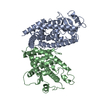 1prgS S: Starting model for refinement C: citing same article ( |
|---|---|
| Similar structure data |
- Links
Links
- Assembly
Assembly
| Deposited unit | 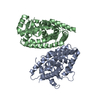
| ||||||||
|---|---|---|---|---|---|---|---|---|---|
| 1 | 
| ||||||||
| 2 | 
| ||||||||
| Unit cell |
|
- Components
Components
| #1: Protein | Mass: 31449.520 Da / Num. of mol.: 2 Source method: isolated from a genetically manipulated source Source: (gene. exp.)  Homo sapiens (human) / Gene: PPARG, NR1C3 / Plasmid: pET46 / Production host: Homo sapiens (human) / Gene: PPARG, NR1C3 / Plasmid: pET46 / Production host:  #2: Water | ChemComp-HOH / | |
|---|
-Experimental details
-Experiment
| Experiment | Method:  X-RAY DIFFRACTION / Number of used crystals: 1 X-RAY DIFFRACTION / Number of used crystals: 1 |
|---|
- Sample preparation
Sample preparation
| Crystal | Density Matthews: 2.67 Å3/Da / Density % sol: 53.89 % |
|---|---|
| Crystal grow | Temperature: 293 K / Method: vapor diffusion, sitting drop / pH: 7.4 / Details: 0.1M Tris, pH 7.4 0.8M SODIUM CITRATE |
-Data collection
| Diffraction | Mean temperature: 100 K / Serial crystal experiment: N |
|---|---|
| Diffraction source | Source:  SYNCHROTRON / Site: SYNCHROTRON / Site:  ALS ALS  / Beamline: 5.0.2 / Wavelength: 0.97946 Å / Beamline: 5.0.2 / Wavelength: 0.97946 Å |
| Detector | Type: DECTRIS PILATUS3 6M / Detector: PIXEL / Date: May 28, 2016 |
| Radiation | Monochromator: Double-crystal, Si(111) / Protocol: SINGLE WAVELENGTH / Monochromatic (M) / Laue (L): M / Scattering type: x-ray |
| Radiation wavelength | Wavelength: 0.97946 Å / Relative weight: 1 |
| Reflection | Resolution: 2.27→58.08 Å / Num. obs: 30849 / % possible obs: 99.5 % / Redundancy: 2 % / Biso Wilson estimate: 22.79 Å2 / CC1/2: 0.997 / Rmerge(I) obs: 0.03669 / Rpim(I) all: 0.03669 / Rrim(I) all: 0.05188 / Net I/σ(I): 8.43 |
| Reflection shell | Resolution: 2.27→2.351 Å / Redundancy: 1.9 % / Rmerge(I) obs: 0.341 / Mean I/σ(I) obs: 1.58 / Num. unique obs: 2997 / CC1/2: 0.862 |
- Processing
Processing
| Software |
| ||||||||||||||||||||||||||||||||||||||||||||||||||||||||||||||||||||||||
|---|---|---|---|---|---|---|---|---|---|---|---|---|---|---|---|---|---|---|---|---|---|---|---|---|---|---|---|---|---|---|---|---|---|---|---|---|---|---|---|---|---|---|---|---|---|---|---|---|---|---|---|---|---|---|---|---|---|---|---|---|---|---|---|---|---|---|---|---|---|---|---|---|---|
| Refinement | Method to determine structure:  MOLECULAR REPLACEMENT MOLECULAR REPLACEMENTStarting model: 1PRG Resolution: 2.27→58.079 Å / SU ML: 0.36 / Cross valid method: THROUGHOUT / σ(F): 1.35 / Phase error: 27.37
| ||||||||||||||||||||||||||||||||||||||||||||||||||||||||||||||||||||||||
| Solvent computation | Shrinkage radii: 0.9 Å / VDW probe radii: 1.11 Å | ||||||||||||||||||||||||||||||||||||||||||||||||||||||||||||||||||||||||
| Displacement parameters | Biso max: 108.51 Å2 / Biso mean: 31.3728 Å2 / Biso min: 5.4 Å2 | ||||||||||||||||||||||||||||||||||||||||||||||||||||||||||||||||||||||||
| Refinement step | Cycle: final / Resolution: 2.27→58.079 Å
| ||||||||||||||||||||||||||||||||||||||||||||||||||||||||||||||||||||||||
| Refine LS restraints |
| ||||||||||||||||||||||||||||||||||||||||||||||||||||||||||||||||||||||||
| LS refinement shell | Refine-ID: X-RAY DIFFRACTION / Rfactor Rfree error: 0
|
 Movie
Movie Controller
Controller


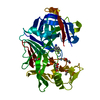




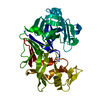
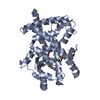




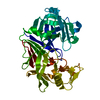







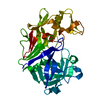
 PDBj
PDBj
